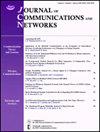EE-TLT:无线传感器网络中使用两级树状聚类的高能效路由协议
IF 3.2
3区 计算机科学
Q2 COMPUTER SCIENCE, INFORMATION SYSTEMS
引用次数: 0
摘要
在为无线传感器网络设计路由协议时,主要的挑战是如何通过有效利用传感器节点有限的电池能量来延长网络的寿命。为了解决这个问题,我们提出了一种节能路由协议,采用基于树的两级聚类方法(称为 EE-TLT)来稳定和有效地利用传感器节点的能量。在 EE-TLT 中,区域网络被逻辑地划分为若干个簇,每个簇中的节点数量保持平衡。在每个簇内,节点又被分成若干个多边形,数据只通过短链路传输,使用两级路由树,该树由一个或多个基于 Kruskal 算法的最小生成树组成,子簇头(sub-CH)节点作为根节点,两级树连接不同多边形的子簇头和基站(BS)。为分别确定每个多边形或扇区的簇头或中继簇头节点,EE-TLT 会考虑候选节点与基站之间的能量残余和距离。此外,EE-TLT 还会在每一轮中选择最佳数据传输阶段长度,从而显著增加 BS 接收到的数据包数量。实验结果表明,在同构和异构网络中,EE-TLT 不仅进一步平衡了传感器之间的能量消耗,而且与 LEACH-VA、PEGCP 和 STDC 相比,BS 接收数据包的比例和能效分别提高了约 25%、15% 和 10%。EE-TLT 的代码和仿真结果见 https://tinyurl.com/ee-tlt-wsn。本文章由计算机程序翻译,如有差异,请以英文原文为准。
EE-TLT: Energy-efficient routing protocol using two-level tree-based clustering in wireless sensor network
When designing routing protocols for wireless sensor networks, the principal challenge is to prolong the network's lifespan by effectively using the limited battery energy of the sensor nodes. To address this issue, we propose an energy-efficient routing protocol employing a two-level tree-based clustering (called EE-TLT) approach to stabilize and efficiently use the sensor node's energy. In EE-TLT, the regional network is logically divided into clusters, with the number of nodes balanced in each cluster. Within each cluster, the nodes are again separated into polygons and the data is transmitted only via short links using a two-level routing tree, which is composed of one or more minimum spanning trees based on the Kruskal algorithm with a sub-cluster head (sub-CH) node serving as the root and a two-level tree linking sub-CHs at different polygons and the base station (BS). To determine the cluster head or relay cluster head node in each polygon or sector respectively, EE-TLT considers the energy residual and distance among candidate nodes and the BS. Furthermore, EE-TLT selects the optimal data transmission stage length in each round, significantly increasing the number of data packets that the BS receives. Our experimental results demonstrate that EE-TLT not only further balances the energy consumption among sensors but also improves the ratio of data packets accepted by BS and energy efficiency compared to the LEACH-VA, PEGCP, and STDC by approximately 25%, 15%, and 10%, respectively, in both homogeneous and heterogeneous networks. The code and the simulation results of EE-TLT may be found at https://tinyurl.com/ee-tlt-wsn.
求助全文
通过发布文献求助,成功后即可免费获取论文全文。
去求助
来源期刊
CiteScore
6.60
自引率
5.60%
发文量
66
审稿时长
14.4 months
期刊介绍:
The JOURNAL OF COMMUNICATIONS AND NETWORKS is published six times per year, and is committed to publishing high-quality papers that advance the state-of-the-art and practical applications of communications and information networks. Theoretical research contributions presenting new techniques, concepts, or analyses, applied contributions reporting on experiences and experiments, and tutorial expositions of permanent reference value are welcome. The subjects covered by this journal include all topics in communication theory and techniques, communication systems, and information networks. COMMUNICATION THEORY AND SYSTEMS WIRELESS COMMUNICATIONS NETWORKS AND SERVICES.

 求助内容:
求助内容: 应助结果提醒方式:
应助结果提醒方式:


